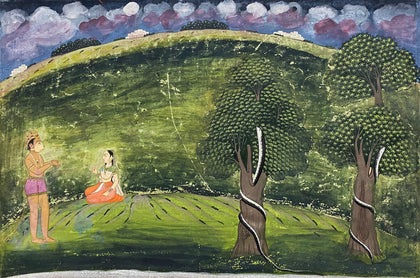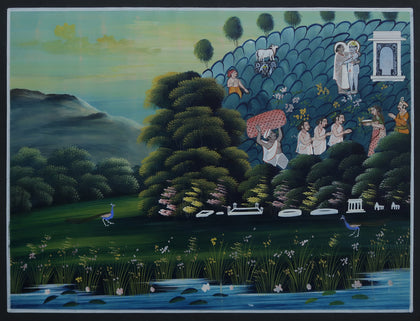Description
This is an exquisite Pahari or Guler School painting of the victorious Varaha rescuing the Earth. Varaha ("boar") is an avatar of Vishnu, in the form of a boar. Varaha (or Varaham) is depicted here lifting the Earth out of the cosmic ocean. There is a legend that when the demon Hiranyaksha stole the earth and hid her in the primordial waters, Vishnu appeared as Varaha to rescue her. Varaha slew the demon (seen here in the bottom right of painting) and retrieved the Earth (seen here above Varaha’s head) from the ocean, and restored her to her place in the universe. Varaha is sometimes depicted as complete boar, or in this case, an anthropomorphic form, with a boar's head and human body. Varaha has four arms, two of which hold the Sudarshana chakra (discus) and a gada (mace), while the third holds a shankha (conch) and the fourth grips the hair of the demon Hiranyaksha.
There is some time related wear and tear noted in this painting. A tear exists on the top left, the centre portion of the right border, and two small tears towards the bottom right. Light fold marks can be seen on the top left and top right. Some water stains ae visible in the top half of the painting.
About the Guler School of Painting
Guler was a small Indian hill state in the lower Himalayas, in modern-day Himachal Pradesh. The kingdom was founded in 1415 by Raja Hari Chand, a descendant of the royal family of Kangra. In the first half of the 18th century a family of Kashmiri painters, trained in Mughal painting, sought shelter at the court of Raja Dalip Singh (1695-1741) of Guler. This was the beginning of what came to be called the Guler style, though in its early phase it was known as Kangra art because of the royal family name. The Guler School of painting is also known under the umbrella term Pahari painting (literally meaning a painting from the mountainous regions, as 'pahar' means a mountain in Hindi). The term 'Pahari Painting' is used for a form of painting, done mostly in miniature, originating from Himalayan hill kingdoms of North India, during 17th-19th century, notably Basohli, Mankot, Nurpur, Chamba, Kangra, Guler, Mandi, and Garhwal.
























































































 View Full Screen
View Full Screen



































